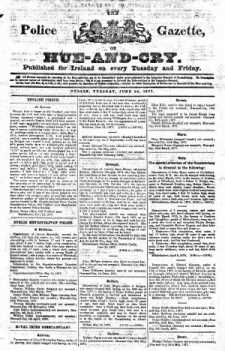Following the successful completion of one of its World Archives Projects, which sees record collections indexed by volunteers, Ancestry has added the Irish Police Gazettes, 1861-1893 to its database. This twice-weekly paper, better known as the 'Hue and Cry', was the official publication of the Royal Irish Constabulary (RIC) and was a means to communicate secretly between members of the police divisions.
The online collection comprises 150,000 indexed entries covering 28,353 reported crimes, 28,092 reports of breaking of License conditions, and 23,345 reports of theft. It is full of missing persons (including army deserters), wanted criminals, habitual criminals and details of those who had been apprehended.
In addition, all editions published during the stated 32 year period can be browsed.
Among the entries are reports of stolen heifers and the like, which might be of minor interest if the owner was an ancestor, but the level of detail in some of the reports of more serious crime can be outstanding.
Take this example from 9 July, 1878:
Sligo: The special attention of the Constabulary is directed to the following:
Description of Thomas Hunt (mother's surname Quigley), native of Knockgranagh, who stands charged with having, on the 29th November ult., in barony of Leyny, parish of Achonry, murdered John McGloin by fracturing his skill with a large stone: - Down-looking appearance, two upper front teeth large and prominent, high cheek bones, large heavy lips, sunken jaws, very broad shoulders; it is also stated that Hunt's left wrist is tattooed; glaring black eyes, slightly cocked nose, sallow complexion, oval face, stout make, 5 feet 9 or 10 inches high, about 27 or 28 years of age, black hair, small dark moustache; wore a dark cloth coat, trowsers, and vest. Was in America, and lately returned from England, where he worked as a labourer. Has a pair of English-made navvy boots with iron plates under toes, also a pair of light Wellington boots.
Tubbercurry, Dec 9, 1876.

